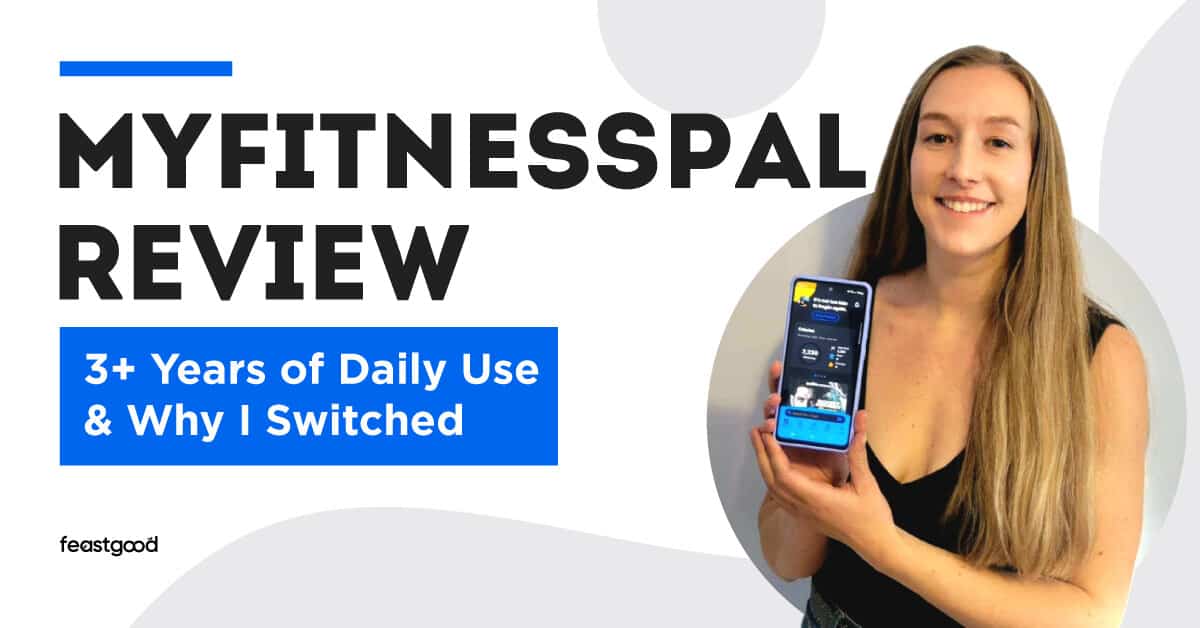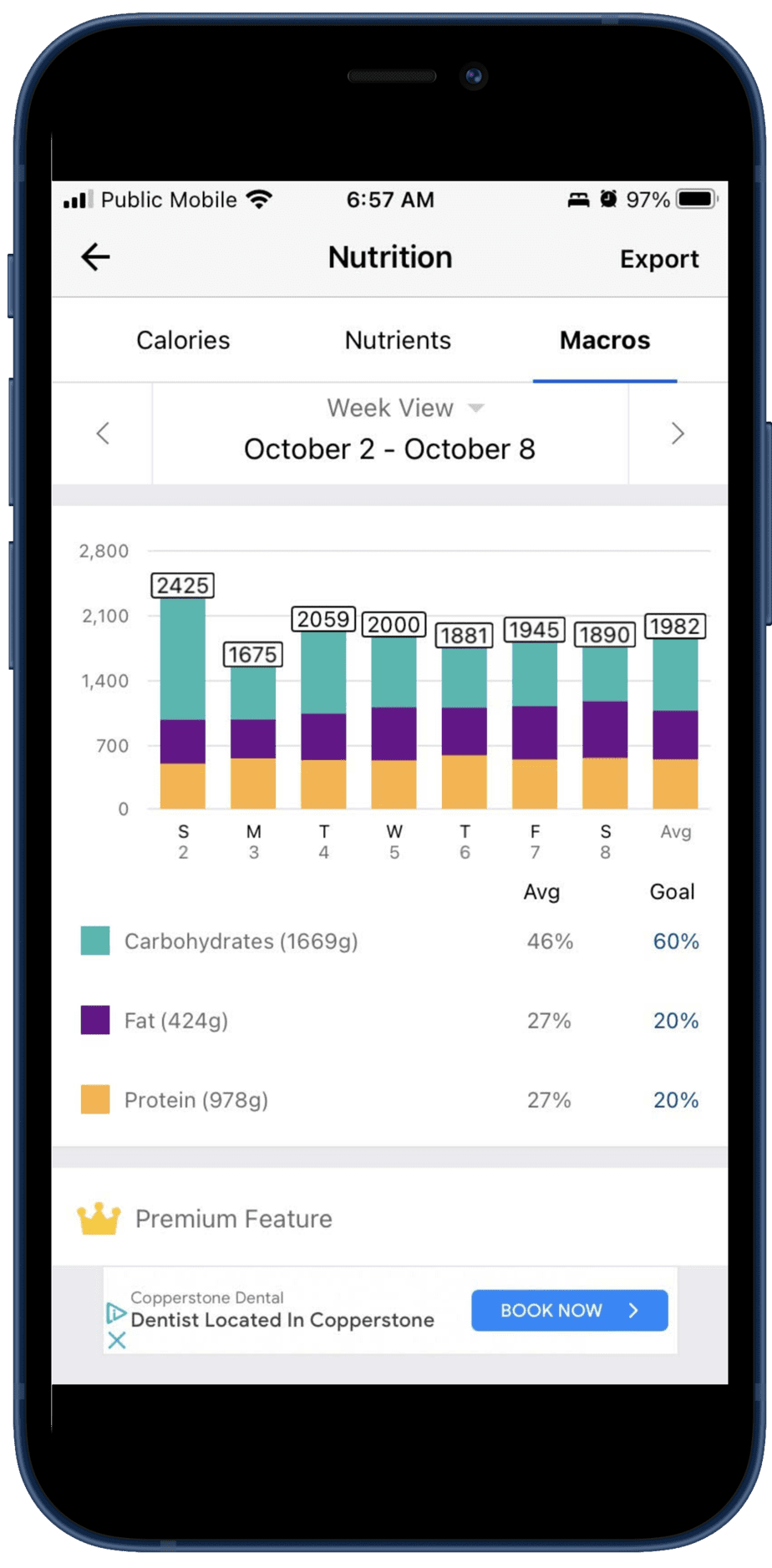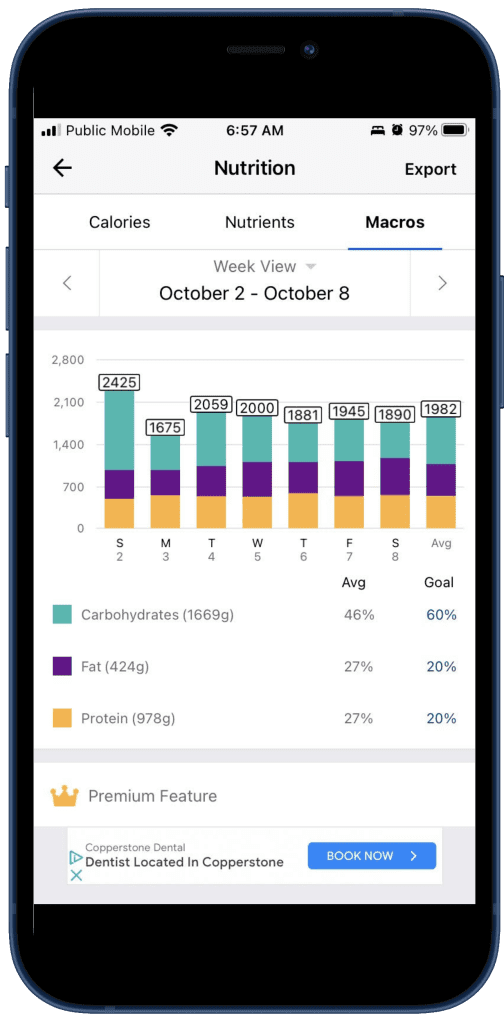Some links in this article are affiliate links, which means we earn from qualifying purchases. Learn more.
Yes, you read that correctly – I used MyFitnessPal for over 1000 days, logging my food nearly daily as I pursued various fitness and nutrition goals.
Sometimes, I wanted to lose body fat. Sometimes, I wanted to gain muscle. And sometimes, I wanted to optimize my performance in a specific sport or competition.
I’ve tried both the free and premium versions of the app, and I’ve used it alongside several other popular calorie and macro trackers.
With all that experience, I’m looking forward to sharing my honest thoughts about the app.
Key Takeaways
Honest Review Guarantee from FeastGood: Our testing team purchases each product 100% independently and uses the product for several weeks up to several months before writing a review. Learn more about our review process here.
- MyFitnessPal was one of the first popular calorie & macro-tracking apps. The free option is still great for people who want to track their food intake. Just be aware that the free version comes with a lot of intrusive ads.
- MyFitnessPal has fewer details, customizations, and built-in coaching features than many other diet apps on the market today.
- While the app allows you to create recipes and meals, there are a lot of inaccurate entries in the food database.
- More and more previously free features are now only available in the paid premium version, including the “barcode scanner” that allows you to quickly log food.
- In my opinion, premium is not worth it because, at nearly $20/month, other apps on the market can now do what MyFitnessPal does (even better in some instances) at half the cost.
- If you’re a beginner just starting to track calories and macros, I now recommend using MacroFactor instead (click to read my review).
Medical Disclaimer: The content of this article is provided for educational insights only. It should not be used as medical guidance. Individuals with a past of disordered eating should refrain from weight loss programs or calorie tracking. For medical advice, consult a certified healthcare professional. If you’re struggling with eating disorders, contact NEDA for assistance.

What Is MyFitnessPal?
MyFitnessPal was one of the very first calorie and macronutrient trackers to explode on the market, released in September 2005 after creator Mike Lee, a Silicon Valley executive, developed it to help him and his fiancee to slim down for their 2003 wedding.
MyFitnessPal started as a desktop product (and you can still sign up and access your account on a desktop), and it was launched as an app for iPhone in December 2009.
What really took the app over the top was its barcode scanner, which launched in July 2011, and the fact that it allowed its own users to input food information – a form of crowdsourcing that allowed the app to build up a massive, global database much faster than if it tried to do it in-house.
Nowadays, MyFitnessPal is like many other calorie and macronutrient apps on the market – it takes the information for the foods you log to tally up your calorie and macronutrient intake for the day, and compares it to your activity level, targets, and current weight to predict how much weight you will lose (or gain) in the next month.
You can sync MyFitnessPal with various activity trackers. Data flows both ways: you can import activity and step counts into MyFitnessPal to increase your estimated energy burn for the day (now only a paid feature), and you can also export calories consumed information to other apps.
MyFitnessPal: Quick Overview & My Experiences
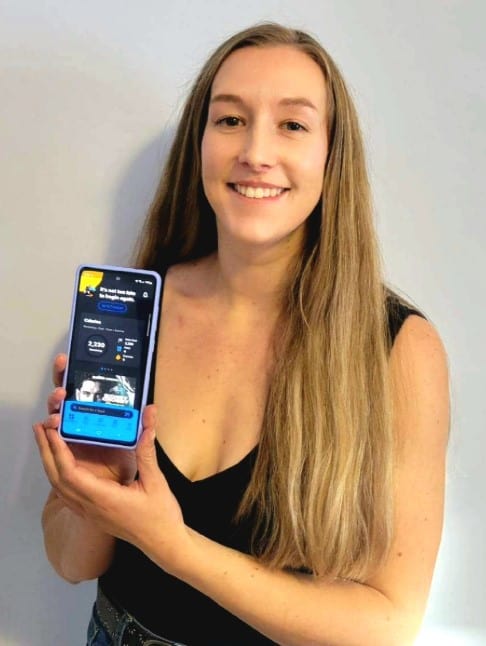
I started using MyFitnessPal for the first time in January 2015. I used it off and on over the years, and I loved that it had my history to refer back to as far as intake, weight, progress photos and my recipes and meals. Now, the app only retains two years of history.
When I started tracking my intake on a more full-time basis, MyFitnessPal was my go-to choice because of how easy it was to use. I found the interface very simple and straightforward, and the main display showed me calories and macros by meal, with a running total at the bottom compared to my goals.
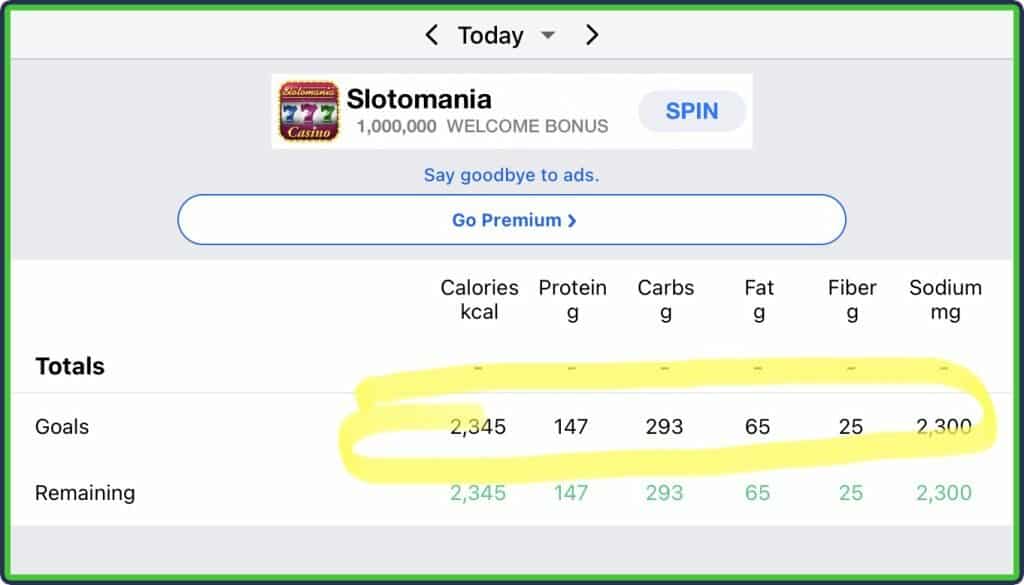
All of this was available in the free version of the app so I never felt the need to upgrade.
Even when they took away the barcode scanner in the free version (in mid 2022), I didn’t see that as a major obstacle for myself, but I know it has a major negative impact on many users.
For me, often the barcode scanner wasn’t pulling up the accurate nutrition information, so I had to search by typing the product name in the search bar anyway.
I also liked that there were entries for pretty much any food at any restaurant, but it did take a little bit of “quality control” to make sure that the macronutrient and calorie information was reasonable, and that it made sense.
For example, I’d sometimes see entries with very low calories, but very high macros, or vice versa. This could have been a typo because of how the food database is crowdsourced (i.e. someone accidentally typing 10 calories instead of 100 calories) or just a total error.
I’d also see entries with calories but no macro information. This would work for those ONLY tracking calories, but not if you wanted to track macros.
I was able to do this quality control because of my education and experience with fitness and nutrition, both from working with coaches and also getting certified as a nutrition coach myself.
But, a new user wouldn’t be able to easily identify poor data, so an app with a verified database (like MacroFactor – my #1 go-to macro tracking app now) might make more sense for them.
How Does MyFitnessPal Work?
When you sign up for MyFitness Pal, you fill out a general profile with your height, sex, weight, and other personal details. Then you can set goals based on your starting weight, goal weight, and activity level.
To use the app, you type the name of the food, or scan the barcode if you have the premium version. You record how many servings you had (and you can input fractions or decimals), and the app records the calorie and macronutrient information.
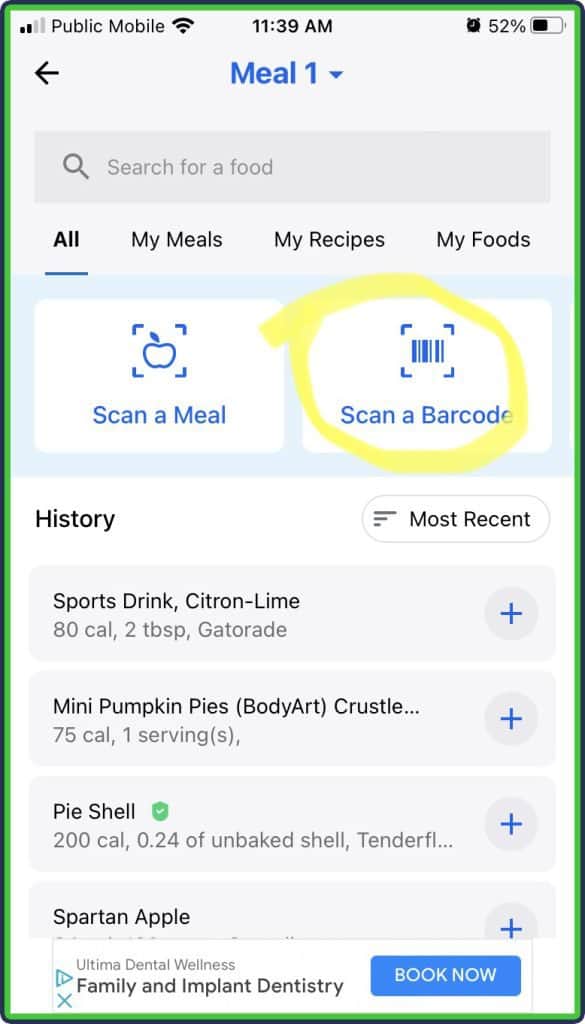
You record all of your food & beverages for the day (logging water is optional), and you can also choose whether to record/import exercise. The app will show the total calories and macros per meal, as well as the running totals for the day compared to your targets.
In the premium version of the app, you can even set calorie/macro goals per meal, and you can record timestamps so that you know what time you ate what foods. This could be helpful to see how much you are eating, when, and to make sure that it lines up with your activity levels at different times of day.
I actually found it to be too much extra work for my taste, since I often log foods in advance to help me plan my meals for the day. Taking the time to update the timestamps to match the times I actually ate the food was extra time that didn’t feel worth it to me.
In the Premium version, you can choose whether the app adds additional calories to your target based on exercise/steps, or stays at the same baseline target (this functionality used to be in the free version, as well).
Whether this feature is helpful or not depends on your goals. For a user looking to lose weight, it’s usually better to stick to the predetermined target which already considers your stated weekly exercise and activity levels to ensure you maintain a calorie deficit for weight loss.
If you “eat back” the calories you’ve burned by exercise, then you erase the deficit and end up with an intake that helps to maintain your weight, rather than lose it.
On the other hand, if you have an extra workout or activity (for example, you go for a long hike on the weekend and you don’t normally hike), it can be helpful to know that in that special case, you should eat a bit more to meet that extra energy need so that you don’t end up starving and risk out-of-control overeating.
And if your goals are for gaining muscle or maximizing sports performance, then it is important to eat the extra calories burned by your exercise, in which case you would want the calories burned by exercise added to your totals.
When you complete logging for the day, the app will give a projected weight in 5 weeks, assuming every day was the same. While this ‘weight projection’ feature is unique to MyFitnessPal, the target isn’t likely to be accurate, so I didn’t find this to be a helpful feature.
First of all, it’s unlikely that you will have the exact same intake and the exact same activity level each day, so your calorie deficit or surplus won’t be exactly the same every day. This projection feature assumes that it will be.
Next, as you lose (or gain) weight over time, the number of calories that it will take to continue losing (or gaining) weight will change as your body changes.
As your body gets smaller, you will need to eat fewer calories to continue losing weight. If you are bulking, as your body gets bigger, you will need to eat more calories to continue gaining weight. This feature ignores this fact.
Finally, there are weekly bar charts that show the calorie intake either by meal (so you know your highest-calorie meals) or by macro (so you can visually see how much of your intake comes from each of protein, carbs, or fat). I found these charts helpful to see patterns over time, including days of the week where I was likely to eat more or less.
- Related Article: Calories on Rest Days (7 Rules To Follow)
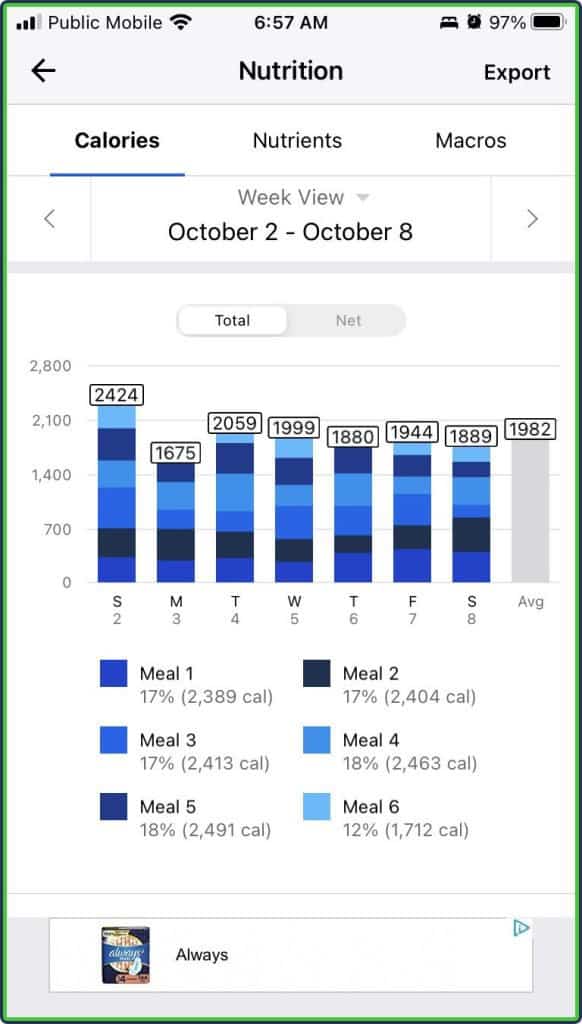
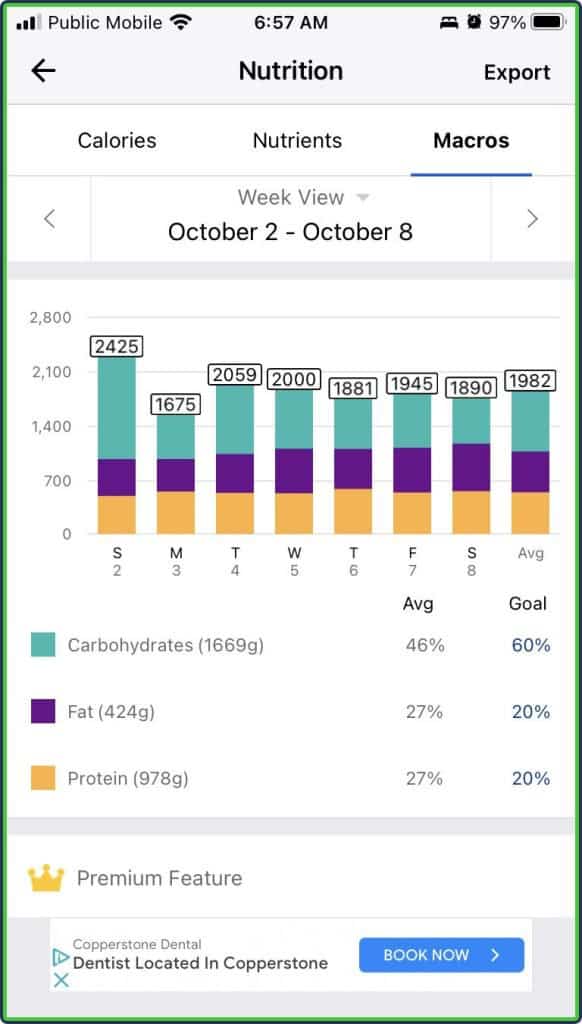
Related: Best Apps For Weight Gain: Determine MyFitnessPal’s position on this ranking.
What I Liked About MyFitnessPal
There were clearly lots of things I liked about MyFitnessPal (MyFitnessPal) for me to continue using it over a seven-year span, and nearly daily for three years.
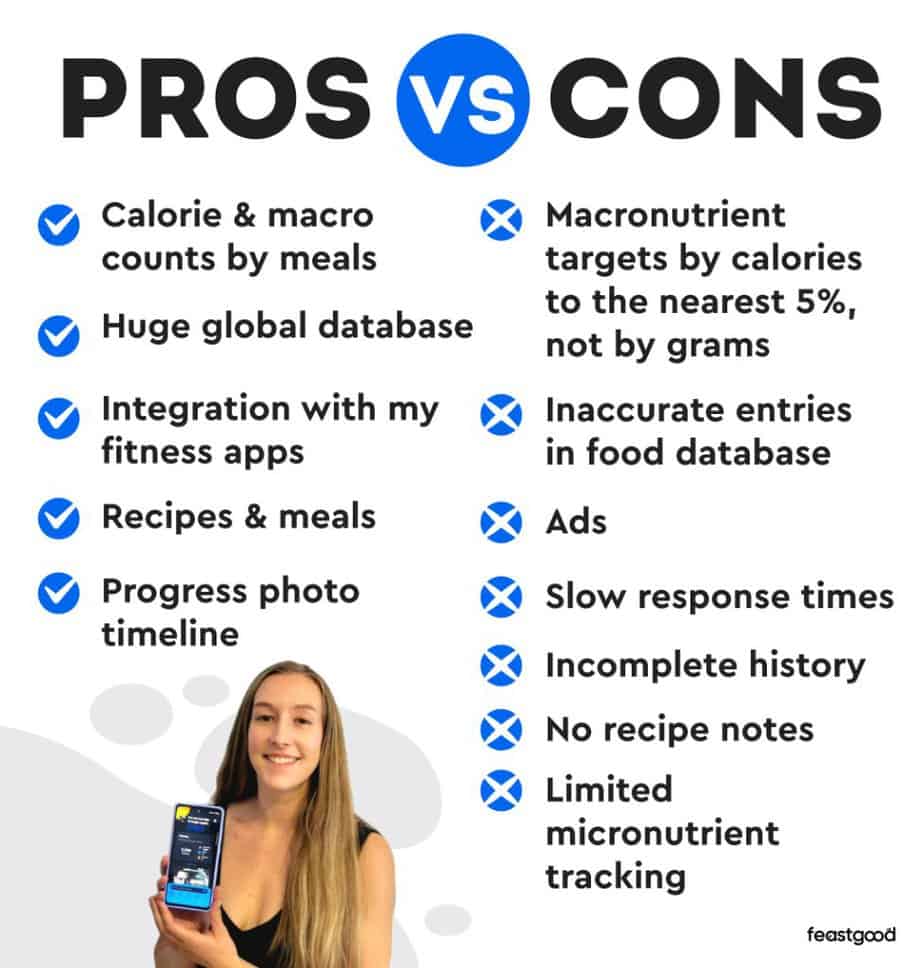
Calorie & macro counts by meals
Calorie & macro counts by meals are available in the free version of MyFitnessPal. I was actually really surprised to find out that on many other apps this feature is only available on premium plans (i.e. Cronometer).
With that said, MyFitnessPal does have a maximum of only six meals, even in the premium version, which sometimes wasn’t enough for me to record all of my meals and snacks, especially on competition days (I compete in Crossfit).
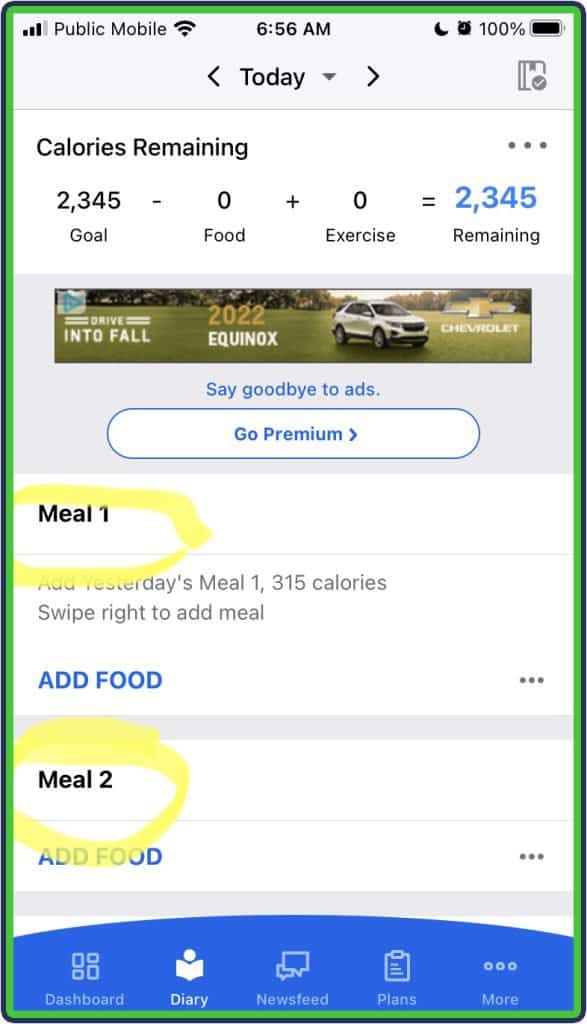
Huge global database
The food database includes entries from all over the world, even if the packaging isn’t in English. This was extremely helpful to me when I was living in Asia because even if I couldn’t read the nutrition label, once I scanned it I knew the calorie and macro information, and the serving size.
This functionality is harder to use now, though, because the barcode scanner is no longer free. You’d likely need to know how to type the product name in the original language (for example, Korean), to find the item in the database, or pay for the premium version to be able to find it.
Integration with my fitness apps
MyFitnessPal data syncs with my Garmin app, and vice versa. My Garmin wristwatch is what I use to track my resting heart rate, daily step count, sleep, and running workouts. It easily imports my “calories eaten” information from MyFitnessPall.
Looking the other way, My Garmin exercise information also easily transfers to MyFitnessPal. In the premium version, I can choose whether or not I want to adjust my calorie target for the day upwards to take into account the calories I’ve burned through exercise (this used to be a choice in the free version, as well).
Recipes & meals
MyFitnessPal has recipes for when you use standardized ingredients in standardized amounts, and meals for when food items are commonly eaten together, but the amounts can vary.
I really liked this distinction because when I am baking a cake, it’s important for me to use the exact ingredients in the exact amounts (recipe feature) but when I am making a stir fry, I might be changing the amounts or adding/omitting ingredients based on what I have on hand (meal feature).
Progress photo timeline
MyFitnessPal stores a scrollable timeline of uploaded progress photos so that you can easily see changes over time.
I make sure my progress photos are in the same outfit, same location, and same pose, and swiping along the timeline makes it easy to see the ways in which my body is (or isn’t) changing.
What I Didn’t Like
In recent years, I found that the MyFitnessPal experience went downhill in a few areas. And, when I started to check out other apps, I saw features that I realized were missing in MyFitnessPal, even in the Premium version.
Macronutrient targets by calories to the nearest 5%, not by grams
In the free version of MyFitnessPal, it’s only possible to set macronutrient targets based on the percentage of total calories they provide. For a while, there was a free desktop extension that enabled users to set targets to the exact gram, but it wasn’t an official part of the app, and it didn’t always work.
For example, if my calorie target was 2,000 calories, I could specify 20% or 25% to come from protein (only increments of 5%, so not 22%), meaning 100g or 125g of protein, but there was no way to set a target that fell between 100-125g, such as 110g of protein.
Inaccurate entries in food database
The food database in MyFitnessPal has hundreds (likely thousands) of inaccurate, incomplete or outdated entries, and many estimates for the same food vary wildly.
I have enough experience and knowledge to know which estimates are reasonable, but a new user could end up with dramatically higher or lower calorie and macronutrient information than what they were actually eating, which would make it extremely hard to make progress toward goals.
Ads
The free version of MyFitnessPal has banner ads in the diary, and full-page ads that pop up and make it slower to input your food.
These ads can be annoying, distracting, and clicking to close them is time consuming, which makes the app more frustrating to use.
(I say this knowing that you’re probably seeing a few ads on the screen right now as you’re reading this article).
Slow response times
The app can be slow to return database results (perhaps because the database is SO big, and is bloated with inaccurate entries) and even saved recipes.
I find that for some of my less commonly used recipes, I have to refresh the search a few times and wait 10-20 seconds for the recipe to appear.
Incomplete history
MyFitnessPal now deletes historical entries more than two years old (as of December 2021).
I used to have my entire history stored in MyFitnessPal, and I was disappointed to find out that my entries from a few years ago are gone now.
I raced a half marathon in 2017, and it would have been nice to go back to my nutrition records from that time to help me plan for my next running program.
No recipe notes
MyFitnessPal does not have any functionality to store notes about how to prepare a recipe, only the ingredients themselves.
I would have to go back to the original recipe cookbook or website (if I could find it) to get the directions about how to prepare it.
I didn’t realize how much of a problem this was until I saw that the recipe function in other apps has a space to record notes.
Limited micronutrient tracking
MyFitnessPal only tracks Vitamin A, Vitamin C, Calcium, Iron, Sodium, and Potassium as far as micronutrients.
This pales in comparison to the 82 micronutrients tracked in other apps, like Cronometer for example.
- Check out my article comparing MyFitnessPal vs Cronometer
Key Features & Benefits
| Feature | Benefit |
|---|---|
| Meal groupings with totals are available for free | Being able to see what foods are eaten together, when, and the total calories and macronutrients for meals is really helpful to determine whether macro splits are appropriate for that particular meal and snack. For example, you can easily see if pre- and post-workout snacks are low in fat and fiber so that they can be digested quickly. |
| Save groups of foods as meals | Being able to save groups of foods that are commonly eaten together as meals make it really fast to log food, which makes the app quick and easy to use. |
| Save recipes | Recipes as a separate feature when it’s important to keep the same ingredients and quantities is a great benefit for people who like to cook or bake, so they can know exactly the calorie/macro information for homemade recipes. |
| Global database | The global database makes it easy to stay on track even while traveling or on vacation, which are common times when people are less likely to track. |
| Restaurant foods | There are so many entries from so many restaurant chains that this is no longer a barrier for people who routinely eat out. When users have to constantly input Custom Foods because restaurant entries are not in the verified database, they are less likely to use the app. |
| Common entries are stored first | The search feature in MyFitnessPal will start with the most recently eaten foods for that meal, rather than having to search from scratch every time, which is another feature that makes the app fast and easy to use. |
What Other Customers Think
MyFitnessPal is rated 4.7 out of 5 stars in the Apple App Store, with nearly 1.5 million ratings, but only scores 4.2 stars based on 2.53 million reviews in Google Play. But recent reviews and ratings are trending downward, with many unhappy users.
It seems that a lot of those positive reviews and ratings come from the app’s history. Scanning through dozens of recent reviews (October-November 2022), I see many 1-2 star ratings, with complaints about the barcode scanner becoming a paid feature, the intrusive ads, and the slow response time.
Many other users seem to have had the same experience that I did:
“After many years of using MyFitnessPal, I’ll be leaving. It was once a great app, but has steadily declined.”
Candace Crow
“Used to be a fantastic app. Lately it has become more of a pain that it’s worth.”
Dallas Rigler
“I have used the app for over 7 years and it has progressively gotten worse.”
Wade Hitchcock
MyFitnessPal simply copied and pasted the same response to these reviews, reminding users that they can still search for the food by name in the search bar, now that they cannot scan it.
I feel good knowing that I’m not alone in my recent negative experiences.
How Much Does MyFitnessPal Cost?
There are two tiers in MyFitnessPal: Free and Premium.
Free Membership
The free version of MyFitnessPal is available at no cost. You can search for foods from the global database by typing them in the search bar, and the app will build a history of your most commonly logged food items.
You can set your own calorie target, or accept suggestions from the app based on your goals and your activity level, as well as starting weight and height.
Standard reports and charts are available in the free version, and you can create recipes and meals (although you have to search for ingredients by typing manually since the barcode scanner is a paid feature now).
The biggest drawbacks in the free version are the many ads and pop-ups, and the fact that the barcode scanner has been removed.
When to use the free version: If you already know your calorie and macro targets, you have enough knowledge and experience to identify inaccurate entries, and you are not interested in tracking micronutrients, then the free version of MyFitnessPal is a good choice, especially if you travel internationally and/or eat at restaurants frequently.
Premium Membership ($19.99 Per Month or $79.99 Per Year)
The Premium version of MyFitnessPal is an ad-free version of the free app, with a lot of additional features (many of which used to be free).
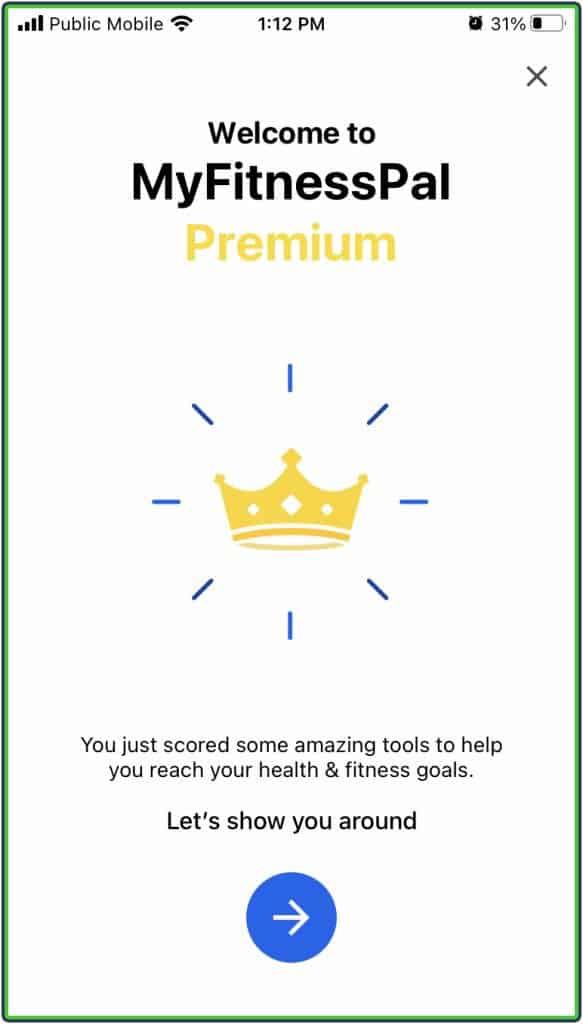
In Premium, you can set customized goals for calories and macros, so that you can set your target by gram or by percentage.
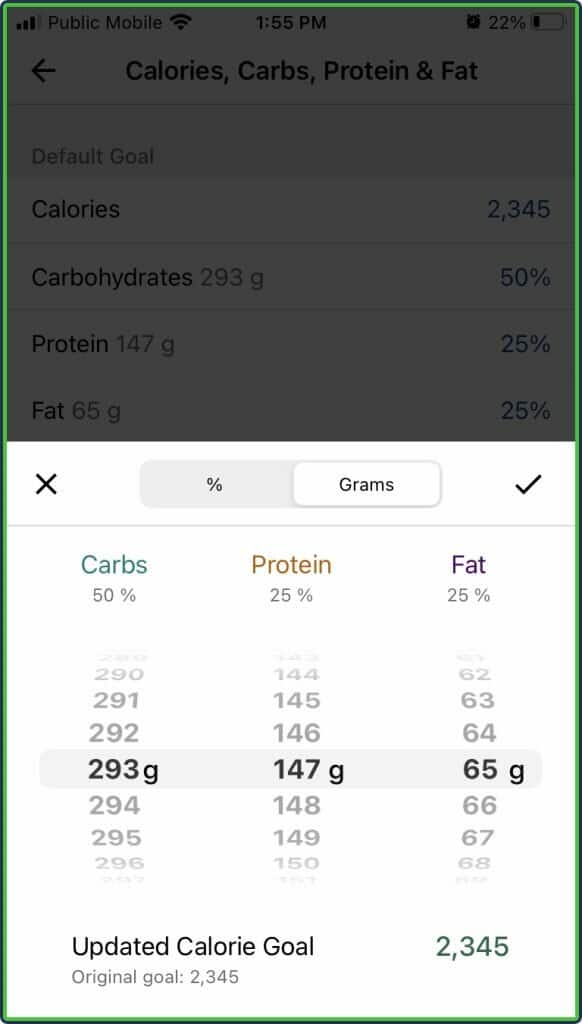
You can also choose whether to adjust the day’s target for imported exercise activity.
When it comes to logging food, the barcode scanner is now only available in the Premium version.
The Premium version also offers meal plans and recipes to follow, and these can be selected for a particular fitness goal such as low-carb.
I am not a fan of meal plans because users are unlikely to stick to them for long, and they don’t learn about how to combine the foods that they actually like and eat most often in ways that will work for their goals.
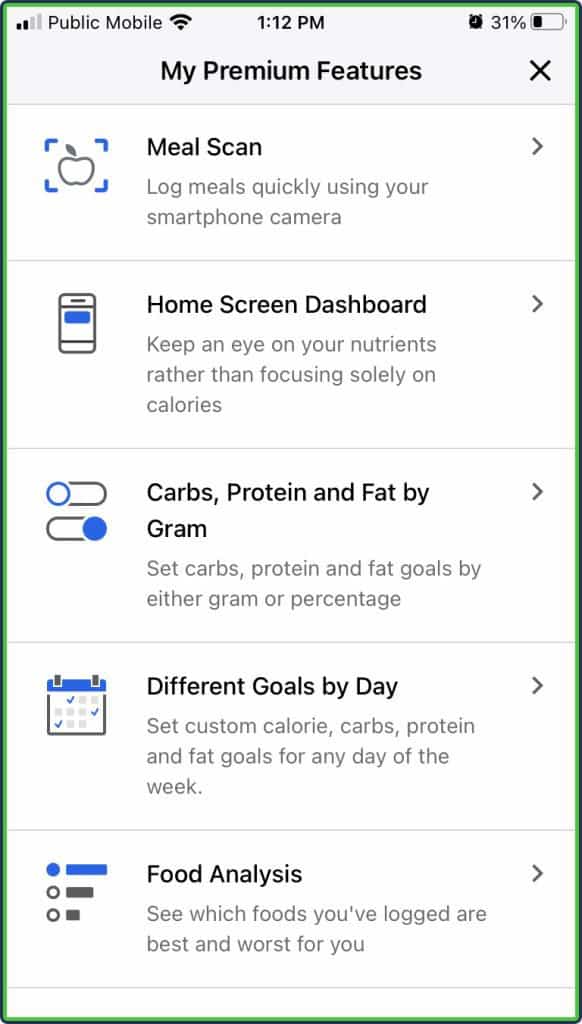
When to use the premium version: If an ad-free experience is worth paying extra, and you would like to see timestamps of when you eat your foods, then MyFitnessPal premium might be worth it. You would still need to be able to identify inaccurate entries.
Who Should Use MyFitnessPal
My recommended candidates for using MyFitnessPal are:
- People who already have experience tracking macros so that they can identify inaccurate entries
- People who travel internationally and need a macro tracker with a global database
- People who regularly eat at restaurants
Who Should NOT Use MyFitnessPal
I do NOT recommend MyFitnessPal for the following types of users:
- Beginners, because they would not have the knowledge or experience to spot inaccurate entries.
- People looking to manage health conditions, as the app does not have enough details about micronutrients
- People with a history of disordered eating or compulsive behaviors around food (I do not recommend any calorie/macro-tracking apps in these cases, since the apps can make these behaviors even worse)
Sign Up For MyFitnessPal
You can easily sign up for a free account at MyFitnessPal on their website.
You answer a few questions about your goals (lose, maintain or gain weight), activity level, sex, height and current weight, and then create your account.
You can also start a 1-month free trial of Premium at any time.
MyFitnessPal Alternatives
I’ve tested 18+ nutrition apps (click to check out the full list). Based on my experience, here are some top 2 alternatives:
MacroFactor – Better For Beginners
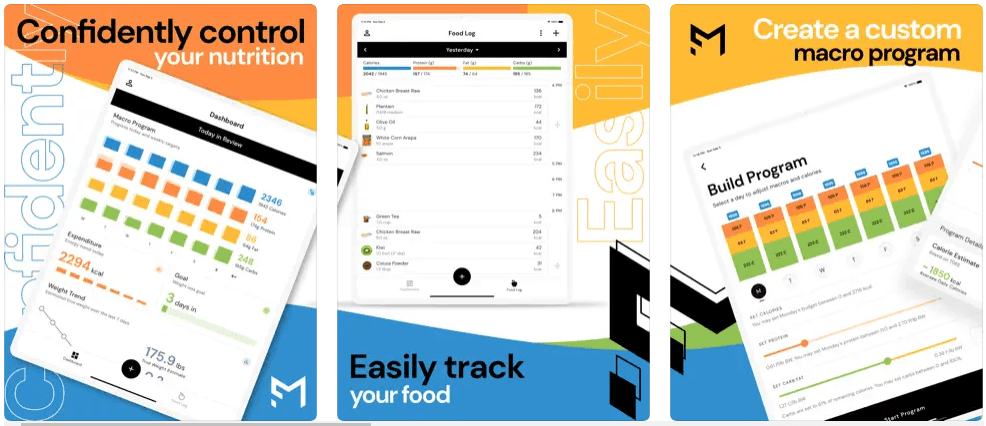
For people who are new to tracking macros, and want to get the education so that they can meet their goals and learn to spot inaccurate entries like the ones in the MyFitnessPal database, I recommend MacroFactor.
This app provides education to users and has a database of foods that have been verified by a Registered Dietician.
Enter code FEASTGOOD when signing up to get an extra week on your free trial (2 weeks total). You can cancel anytime before your trial ends without being charged.
Noom – Most Coaching For Weight Loss
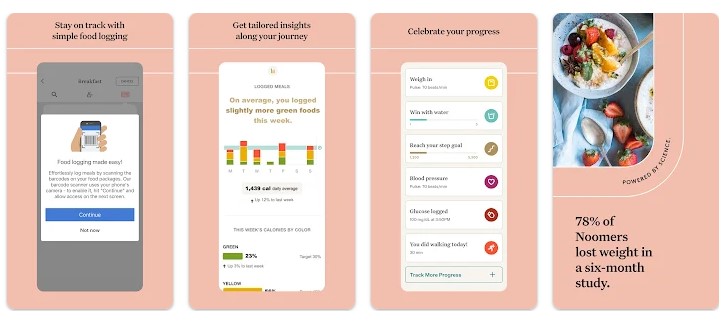
The Noom weight loss app comes with a higher price point, but it actually has a live coach who can help you learn about healthy foods and actual behavioral psychology to help you change the way you eat, for good.
MyFitnessPal Comparisons
Frequently Asked Questions
Is MyFitnessPal Good For Weight Loss?
MyFitnessPal can be good for weight loss compared to not tracking at all, especially if you are careful about finding only accurate database entries for the foods you eat. But, if you select inaccurate entries that have understated calorie counts, you can actually end up gaining weight while using MyFitnessPal.
Is MyFitnessPal Free?
The basic version of MyFitnessPal is free. It allows you to manually search the global database for foods to add to your daily diary, where you can group foods in up to 6 meals. Total calories & macros will be displayed per meal. The Premium version (monthly or annual fee) unlocks many features like a barcode scanner.
Is MyFitnessPal Compatible With Apple Watch?
Yes, MyFitnessPal is compatible with Apple Watch. You can sync your MyFitnessPal account with Apple Health, which allows you to view MyFitnessPal data such as calories remaining from the Apple Watch app, and you can import activity, like daily step count or workouts from your Apple Watch to MyFitnessPal.
Is MyFitnessPal Accurate?
No, the MyFitnessPal database is not very accurate because many of the entries are user-sourced and user-verified. The app does also have many accurate entries, but it would take an educated user with previous knowledge and experience to know the difference between the accurate and inaccurate entries.
How Do I Cancel My Subscription to MyFitnessPal?
If you have a subscription to MyFitnessPal Premium, you will need to cancel using the same method that you used for sign-up: iOS subscriptions for Apple iphone are managed in iTunes Subscriptions. Android subscriptions are managed in the Google Play Store, & website subscriptions are managed from Subscription Settings.
How Do I Contact MyFitnessPal?
MyFitnessPal has a support page where you can submit a request via an online form, but there are no direct email addresses or phone numbers for support. Many users have expressed complaints about not being able to get support timely from MyFitnessPal.
Other Diet App Reviews
- RP Diet App Review
- Lifesum App Review
- Lose It! App Review
- Avatar App Review
- MyNetDiary Review
- BetterMe App Review
- MyMacros+ App Review
- Fooducate App Review
- Carbon Diet Coach Review
- FatSecret Review
- Macrostax App Review
- My Diet Coach App Review
About The Author
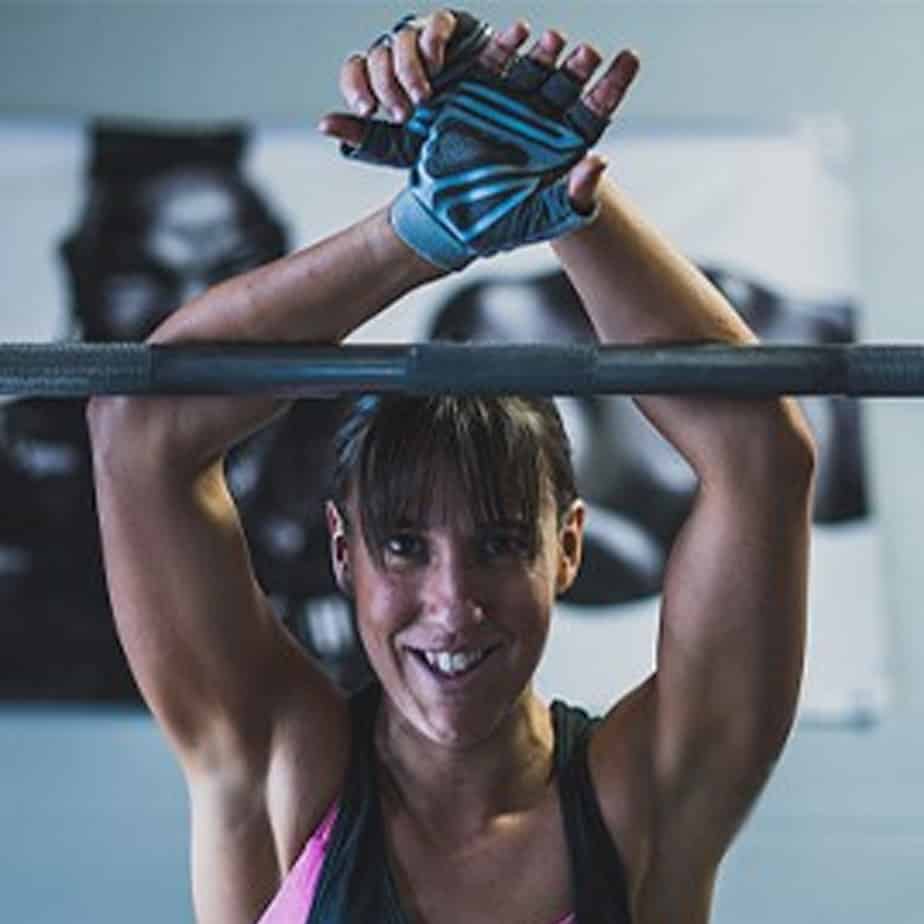
Lauren Graham is a Precision Nutrition Level 1 certified nutrition coach. She focuses on helping busy professionals balance healthy eating and purposeful movement. Lauren has a background in competitive swimming and is currently competing as a CrossFit athlete. She has a passion for training, teaching, and writing.
Why Trust Our Content

On Staff at FeastGood.com, we have Registered Dietitians, coaches with PhDs in Human Nutrition, and internationally ranked athletes who contribute to our editorial process. This includes research, writing, editing, fact-checking, and product testing/reviews. At a bare minimum, all authors must be certified nutrition coaches by either the National Academy of Sports Medicine, International Sport Sciences Association, or Precision Nutrition. Learn more about our team here.
Have a Question?
If you have any questions or feedback about what you’ve read, you can reach out to us at [email protected]. We respond to every email within 1 business day.
